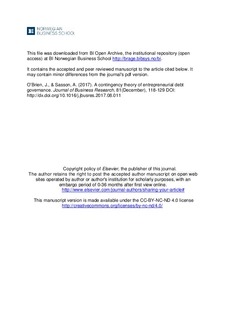A contingency theory of entrepreneurial debt governance
Journal article, Peer reviewed
Accepted version
Permanent lenke
http://hdl.handle.net/11250/2452246Utgivelsesdato
2017Metadata
Vis full innførselSamlinger
- Publikasjoner fra CRIStin - BI [1015]
- Scientific articles [2181]
Originalversjon
Journal of Business Research. 2017, 81, 118-129 http://dx.doi.org/10.1016/j.jbusres.2017.08.011Sammendrag
Access to debt can be crucial for entrepreneurs who need capital. Embedding economic ties within a social relationship with the debt provider can ensure capital availability and attenuate opportunism. However, such a relationship requires substantial investments in time and effort. We advance a solution to this entrepreneurial conundrum by proposing a contingency theory which prescribes aligning the fundamental transactional properties (i.e., asset specificity, uncertainty and frequency) with the nature of the entrepreneur-bank relationship (i.e., embedded versus arm's length). Our theory predicts that transactional properties affect the optimal governance of the entrepreneur-bank relationship, and that social embeddedness can transform what looks like a market transaction (e.g., a debt transaction) into a hybrid form of governance more akin to a hierarchy. Using a sample of small businesses in the U.S., we find that congruence between the optimal governance structure and the actual governance structure results in higher firm performance
Beskrivelse
The accepted and peer reviewed manuscript to the article
